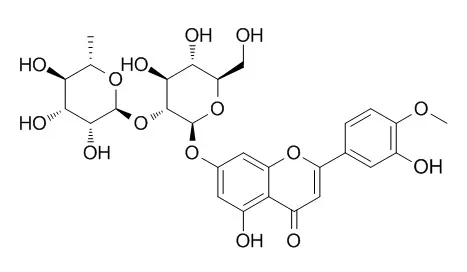| Structure Identification: |
| J Agric Food Chem. 2013 Feb 27;61(8):1686-93. | | HPLC-PDA-MS and NMR characterization of a hydroalcoholic extract of Citrus aurantium L. var. amara peel with antiedematogenic activity.[Pubmed: 22957519] | The phytochemical profile of a hydroalcoholic extract of Citrus aurantium var. amara L. peel, used as herbal medicine, was characterized by HPLC-PDA-MS.
METHODS AND RESULTS:
Two di-C-glycosyl flavones (vincenin II and diosmetin 6,8-di-C-glucoside), a series of flavones (luteolin 7-O-neohesperidoside, rhoifolin, and Neodiosmin), and flavanone (neoeriocitrin, naringin, and neohesperidin) 7-O-neohesperidosides and two methoxyflavones (nobiletin and tangeretin), commonly present in Citrus, were identified. Furthermore, brutieridin and melitidin, two 3-hydroxy-3-methylglutaryl flavanone glycosides, were also characterized along with rhoifolin 4'-glucoside and three coumarins (8,3'-β-D-glucopyranosyloxy-2'-hydroxy-3'-methylbutyl-7-methoxycoumarin, merazin hydrate, and isomerazin). A preparative isolation procedure followed by NMR spectroscopy confirmed the proposed structures of the major flavonoids and identified the coumarins.
CONCLUSIONS:
The phenolic content was found to be 14.8 mg mL(-1), and naringin and neohesperidin were the compounds present in the highest concentration (3.6 and 2.6 mg mL(-1)). The extract of C. aurantium peel inhibited significantly (p < 0.05) both histamine- and dextran-induced edema in rats in a concentration-dependent manner (IC(50) = 119.6 and 118.3 mg kg(-1), respectively), providing evidence for the therapeutic use of C. aurantium var. amara peel. | | Starch -Stärke, 2016, 69(5-6):1-9. | | Increased solubility and taste masking of a ternary system of neodiosmin with β -cyclodextrin and lysine: Ternary system for increasing solubility and masking bitter tastes[Reference: WebLink] | Neodiosmin has poor aqueous solubility but exerts a good debittering effect and is a strong antioxidant with potential applications in foods, beverages, and pharmaceutical preparations.
METHODS AND RESULTS:
The water solubility of Neodiosmin was greatly enhanced by forming a Neodiosmin/β-cyclodextrin/lysine ternary inclusion complex. The inclusion type is described in detail in terms of its structural aspects using a phase diagram of solubility. The Neodiosmin/β-cyclodextrin/lysine ternary inclusion complex was synthesized and characterized by thermal analysis and powder X-ray diffractometry (XRD). The molecular and fractal structures of the ternary complexes were investigated using 1H nuclear magnetic resonance (1H NMR) spectroscopy and Fourier transform infrared (FT-IR) spectroscopy. Additionally, scanning electron microscopy (SEM) revealed that Neodiosmin was embedded in a matrix of β-cyclodextrin with lysine.
CONCLUSIONS:
The results demonstrated that the inclusion complex was formed and that the solubility of Neodiosmin was greatly improved. Additionally, the bitterness-masking power of this system was evaluated by a panel test using a series of limonin concentrations as a reference scale. The Neodiosmin/β-cyclodextrin/lysine ternary inclusion complex showed the highest efficacy, and the bitterness attenuation was statistically significant. |
|






 Cell. 2018 Jan 11;172(1-2):249-261.e12. doi: 10.1016/j.cell.2017.12.019.IF=36.216(2019)
Cell. 2018 Jan 11;172(1-2):249-261.e12. doi: 10.1016/j.cell.2017.12.019.IF=36.216(2019) Cell Metab. 2020 Mar 3;31(3):534-548.e5. doi: 10.1016/j.cmet.2020.01.002.IF=22.415(2019)
Cell Metab. 2020 Mar 3;31(3):534-548.e5. doi: 10.1016/j.cmet.2020.01.002.IF=22.415(2019) Mol Cell. 2017 Nov 16;68(4):673-685.e6. doi: 10.1016/j.molcel.2017.10.022.IF=14.548(2019)
Mol Cell. 2017 Nov 16;68(4):673-685.e6. doi: 10.1016/j.molcel.2017.10.022.IF=14.548(2019)